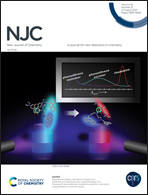Bright photo- and triboluminescence of centrosymmetric Eu(iii) and Tb(iii) complexes with phosphine oxides containing azaheterocycles†
Abstract
Six centrosymmetric mononuclear Eu3+ and Tb3+ complexes of the type [LnL2(hfac)3] have been synthesized employing diphenyl(pyridin-2-yl)phosphine oxide (Ph2P(O)Py), diphenyl(pyridimin-2-yl)phosphine oxide (Ph2P(O)Pym), and diphenyl(pyrazin-2-yl)phosphine oxide (Ph2P(O)Pyr) as supporting ligands (L). The complexes [LnL2(hfac)3] (L = Ph2P(O)Py and Ph2P(O)Pyr) comprise an eight-coordinate Ln3+ ion with two monodentate O-donor phosphine oxides and three bidentate hfac− anions. In the [Ln{Ph2P(O)Pym}2(hfac)3] complexes, the Ln3+ ion is nine-coordinated by three bidentate hfac− anions and two Ph2P(O)Pym ligands, one of which is bound to Ln in a N,O-bidentate chelating mode, and the other acts as a monodentate O-donor ligand. The complexes display bright solid-state photoluminescence with emission quantum yields up to 56%. The integral intensity of 5D0 → 7F2 transition in the emission spectra of the Eu(III) complexes strongly depends on the coordination environment of the Eu3+ ion. The asymmetric coordination geometry around Eu3+ results in the large radiative rate constants. The crystals of the Eu(III) and Tb(III) complexes exhibit triboluminescence upon breaking under ambient conditions. The relationship between the triboluminescent properties and crystal structures of the complexes is discussed.



 Please wait while we load your content...
Please wait while we load your content...